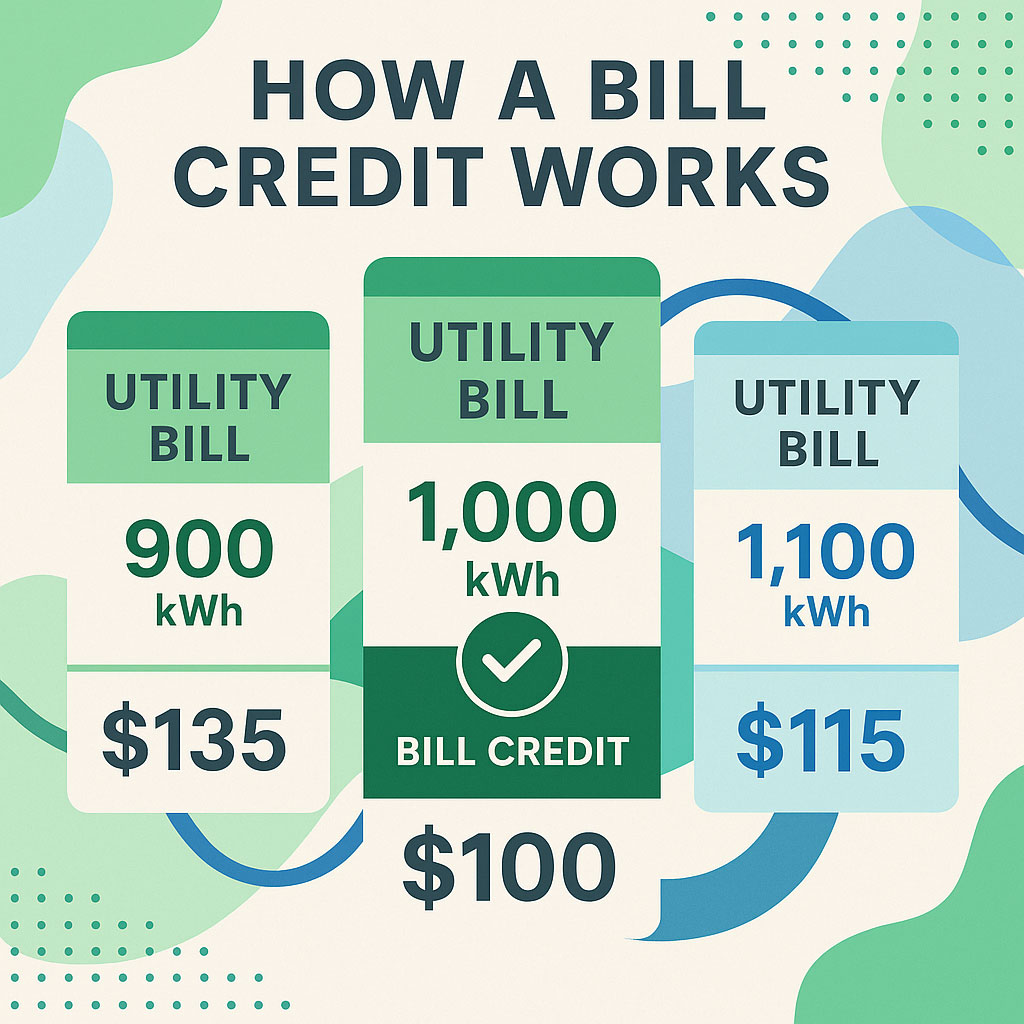If you’re shopping for electricity in a deregulated state like Texas, Ohio, Pennsylvania, or New York, you might run into something called a bill credit plan (also known as a usage credit plan). These plans can offer real savings, but only if they match your usage habits.
What Is a Bill Credit Plan?
A bill credit plan gives you a discount on your monthly electric bill if you use a certain amount of electricity. Think of it like hitting a target, if you reach a specific usage number, you unlock a credit. A bill credit plan is essentially a fixed-rate electricity plan that includes a bonus credit on your bill whenever your monthly usage reaches a certain level. If you hit the target, you pay less (thanks to the credit); if you don’t, you pay the normal rate without any discount.
- Example: Use 1,000 kWh in a month and get $50 off your bill.
- Use 999 kWh? No credit.
This discount applies every month that you meet the usage threshold. It’s not a one-time perk, it’s ongoing.
Why They Exist
The concept is designed to incentivize people to use a bit more electricity (to reach the target) with the promise of a discount or credit once you do. In deregulated markets like Texas, there’s a lot of competition among providers, so bill credits are one way to offer an attractive deal. (In fact, Texas providers often design these plans to look cheapest at specific usage points like 1,000 or 2,000 kWh, because those are standard comparison benchmarks in the market. This can make the plan stand out on rate comparison websites.)
How Do Bill Credit Plans Work?

Under a bill credit plan, your monthly bill can work a little like a game of “hit the target.” Here’s how these plans typically operate:
- Thresholds: The provider sets a minimum usage level, often 1,000 or 2,000 kWh per month in Texas. In other states, this varies and is often based on typical regional usage.
- Monthly credit: If you hit the threshold, you get a fixed credit (e.g., $25, $50, or $100) off your bill.
- Recurring monthly credit: Importantly, this credit can be earned every month that you meet the usage requirement, not just once. Each billing cycle is a new chance to get the discount.
- All-or-nothing: You must hit the minimum. Use just under the limit and get no credit at all.
- Upper limits (sometimes): Some plans only give the credit if your usage falls within a specific range, like between 1,000 and 2,000 kWh.
- Timing doesn’t matter (just total usage): Unlike some other plan types (like time-of-use plans which care when you use electricity), bill credit plans don’t care if you use your power at noon or midnight, it only matters how much you used in the billing period. It’s purely about the total kWh in the month.
Example: A plan offers a $50 bill credit if you use at least 1,000 kWh.
| Monthly Usage (kWh) | Do You Get the Credit? | Your Bill (Assuming 15¢/kWh base rate + $50 credit if earned) | Effective Price per kWh |
|---|---|---|---|
| 900 kWh | No (below 1,000 kWh) | 900 × $0.15 = $135 (no credit) | 15¢ per kWh |
| 1,000 kWh | Yes (hit the 1,000 kWh mark) | 1,000 × $0.15 = $150 minus $50 credit = $100 total bill | 10¢ per kWh |
| 1,100 kWh | Yes (above 1,000 kWh) | 1,100 × $0.15 = $165 minus $50 credit = $115 total bill | ≈10.5¢ per kWh |
You can see how big of a difference that credit makes when you cross the usage line.
Bill Credit Plans vs. Traditional Plans
Here’s how they stack up:
- Fixed-rate plans: Same price per kWh no matter what. No usage games, no thresholds. The big advantage here is predictability: you know exactly what rate you’re paying every month, which makes budgeting easy.
- Bill credit plans: Offer discounts if you use “enough” power, but no partial credit if you fall short.
- Variable-rate plans: Price per kWh changes each month with market conditions.
- Time-of-use plans: Prices vary depending on when you use electricity (e.g., nights vs. afternoons).
Key difference: Bill credit plans reward how much you use, not when you use it.
Traditional fixed-rate plans offer simplicity and steady rates, variable plans offer flexibility but with price uncertainty, time-of-use plans reward shifting your usage schedule, and bill credit plans reward hitting a usage sweet spot. Each type can work for different people.
Who Are Bill Credit Plans Good For?
Bill credit electric plans can be great for some people and not so great for others. It really comes down to your usage patterns and lifestyle. Bill credit plans are great for:
- Homes that consistently use 1,000–2,000+ kWh/month: If you’re in a larger home or have a family and you consistently use a lot of electricity each month, you might be a good fit. For example, let’s say you have a suburban Texas home with central AC, maybe a pool, lots of gadgets, and your usage rarely dips below 1,000 kWh even in mild months. In that case, you could reliably hit the credit threshold every month and pocket the savings.
- “Sweet Spot” Users: Some folks find that their normal usage happens to sit right in the “sweet spot” of a bill credit plan. For instance, a person who lives alone in a large apartment might normally use around 800 kWh. If there’s a plan that gives a credit at ≥800 kWh (like the TXU Energy Smart Edge plan in Texas offers a credit at 800 kWh usage), that could be perfect.
- People Who Don’t Mind Monitoring Usage: Are you the type who wouldn’t mind glancing at your smart meter or usage app periodically to ensure you hit a target? Some consumers actually enjoy this kind of engagement. If you’re energy-conscious and like the idea of optimizing your bill, you could use a bill credit plan to your advantage.
Not ideal for:
- Low Usage Households (e.g., Small Apartments, Energy Misers): If you live in a small apartment or are very frugal with electricity, you might rarely hit the usage threshold.
- People with Highly Variable Usage: Maybe some months you use 1,200 kWh (hot summer, AC on full) but other months you only use 600 kWh (you were traveling, or mild weather). If your usage swings widely, a bill credit plan will make your bills swing widely too, potentially in unpleasant ways. One month you’d get the credit and have a nice low bill; the next month you’d miss it and pay full price, possibly making that month’s effective rate very high. The unpredictable nature of your usage makes it hard to consistently benefit. As a result, budgeting becomes tricky.
- Folks Who Don’t Want Complexity or Risk: This is more of a personal preference. Some people just don’t want to worry about whether they’ve used “enough” electricity in a given month to get a good rate. If you prefer simplicity and peace of mind, the hassle of monitoring usage or the risk of a surprise high bill might not be worth the potential savings.
Pros and Cons of Bill Credit Plans
Pros
- You can save big if you consistently hit the usage threshold
- Credits are monthly, not one-time
- Effective rates can be lower than traditional plans at certain usage levels
- Encourages tracking and managing usage, which some people enjoy
Cons
- No credit if you miss the threshold, even by a little
- Bills can be unpredictable, especially if your usage varies
- May lead to higher energy use just to get the credit
- Often higher base rates, especially if you don’t qualify for the credit
- More complicated to understand and compare
Tips for Choosing a Bill Credit Plan
- Check your past usage
This is the most important step if you’re considering a bill credit plan. Look at your monthly kWh totals from the last year. If you consistently hit the threshold, you’re in good shape. - Read the plan details (EFL or Terms of Service)
Always read the details of any plan before you sign up, this is doubly important for bill credit plans. Look for:- The credit amount
- The usage range (minimum and any maximum)
- Base fees or hidden charges
- Compare Plan Options (and Don’t Be Fooled by Advertised Rates)
It’s always wise to compare several plans side by side. Use your state’s official comparison site if available (for instance, Texas has Power to Choose, Pennsylvania has PA Power Switch, etc.) or other reputable energy marketplaces. When comparing, look beyond the big, bold advertised rate. - Don’t be fooled by the advertised rate
It usually assumes you get the credit. Your real rate could be much higher if you don’t. - Look for trial periods or satisfaction guarantees
Some providers let you cancel without penalty if it’s not working out. - Consider Your Comfort Level: Finally, choose a plan that matches not just your usage, but your personality.
Final Advice
Bill credit plans can save you money, but only if your monthly usage regularly falls into the “credit zone.” If your usage is too low or swings up and down, a simple fixed-rate plan might be better. Don’t let the existence of bill credits intimidate you. At the end of the day, it’s just one style of plan among many. If it’s right for you, it can save you money. If it’s not, you have plenty of other options. The fact that you’re reading a guide like this means you’re already ahead of the game, you’re educating yourself, which is the best thing you can do in a deregulated market!
The best way to shop is to:
- Know your usage
- Understand the fine print
- Compare multiple plans
- Choose the one that fits your lifestyle and comfort level
Cill credit electric plans can be a double-edged sword. They’re great for a certain type of consumer (higher, stable usage) and potentially costly for others (low or unpredictable usage). Take a good look at your own electricity consumption, weigh the pros and cons, and don’t hesitate to choose a simpler plan if you feel unsure. Electricity is not one-size-fits-all, and deregulation is about finding what fits you. Whether you decide to go for that bill credit plan or stick to something traditional, you’ll now do so with eyes wide open and a clear understanding of what you’re signing up for. Happy electricity shopping, and here’s to lower bills and no surprises!
FAQs About Bill Credit Plans
What is a bill credit electric plan?
How do bill credits work?
Do I get the credit every month?
What happens if I don’t hit the usage target?
Can I get part of the credit if I almost hit the target?
Why do bill credit plans sometimes seem so cheap?
Do bill credit plans have cancellation fees?
Is it worth choosing one just for summer or winter?
How can I track my usage to make sure I hit the credit threshold?
About the Author
LaLeesha has a Masters degree in English and enjoys writing whenever she has the chance. She is passionate about gardening, reducing her carbon footprint, and protecting the environment.
